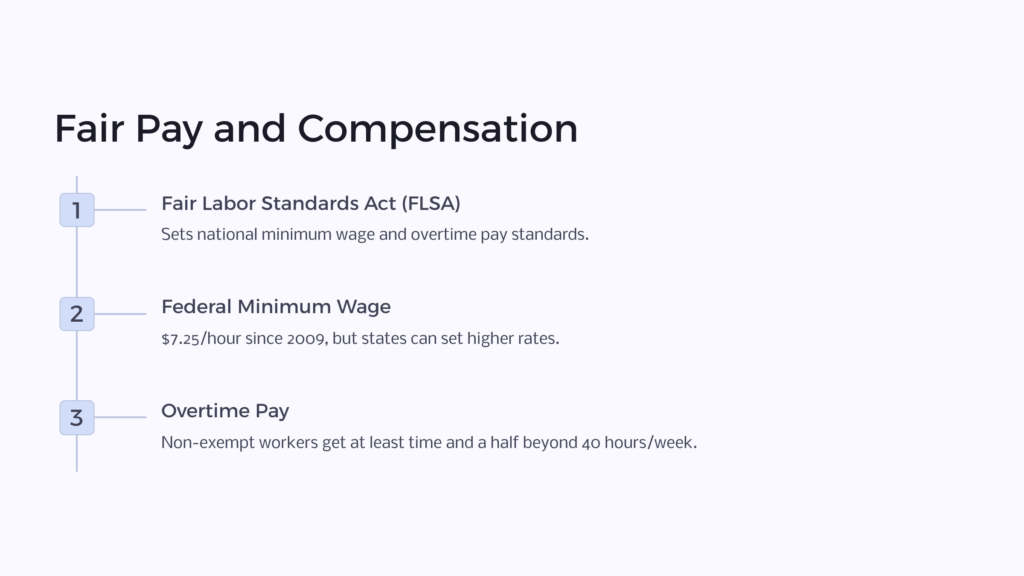With so many rules and standards in today’s workplaces, it can be hard to believe that not too long ago there weren’t comprehensive employment laws in place. Many of these rights were fought for over the decades by workers themselves, politicians, or advocates working through groups like a labor organization. Using tactics such as collective bargaining to achieve better working standards, workers now hold a number of safeguards that protect both their physical and economic interests.
9 Employee Rights for American Workers
- Safe Working Environment
- Fair Pay
- Disability Rights
- Unpaid Leave
- Protection from Harassment
- Protection from Discrimination
- Young Worker Rights
- Farm Worker Rights
- Employee Benefits Packages
Labor laws today cover all workers—young and old, men and women, foreign and domestic, and those in nearly every occupation. We now have laws at both federal and state levels that legislate equal pay, non-discrimination, disability rights, and have improved working conditions for millions.
1. Safe Working Environment

All employees have the right to a safe work environment. Even if you receive generous employee benefits, they are meaningless if you don’t feel safe. The main federal agency that oversees safety standards is the Occupational Safety and Health Administration (OSHA) and its goal is to keep all workers safe and healthy. Through this agency, OSHA’s guidelines cover almost all workplaces in the U.S. with additional rules in place for occupations such as public sector employees, miners, and youth workers.
2. Fair Pay

Each worker is entitled to fair compensation for the work they do. At the federal level, the Fair Labor Standards Act (FLSA) has put laws that govern both private and public employees. The FLSA sets the standard for a national minimum wage, guidance on overtime pay, record keeping, and regulation surrounding youth employment.
The federal minimum wage has been stagnant at $7.25/hour since 2009, but states also have the power to impose their own minimum wages if they wish. If they choose not to, or their minimum wage is lower than the federal wage, the federal wage must be used. There are currently 29 states that have minimum wages higher than $7.25/hr. The FLSA also ensures non-exempt workers get paid overtime wages (at least time and a half) for any work that’s done beyond 40 hours a week.
3. Disability Rights
The Office of Federal Contract Compliance Programs (OFCCP), under the U.S. Department of Labor (DOL) ensures that employees and job applicants are protected from discrimination due to a disability. No one can be denied employment, harassed, threatened, paid less, fired, or demoted because of their disability and an employer must make any “reasonable accommodation” so you can perform your job functions. Anyone who’s qualified and can perform the job with reasonable accommodation (meaning it won’t be considerably expensive or difficult for the employer to enact) cannot be denied employment simply because they have or have had a disability, either physical or mental. Furthermore, the cost of the accommodation cannot be passed on to the employee and must be covered by the employer.
When applying for a job, even if you know you’ll be working with a disability, you’re not legally required to disclose it. However, you will need to inform your employer if you require an accommodation. If you need an accommodation during the interview process, you can ask or have someone ask for you. The employer then must make the accommodation within a reasonable time frame.
Note: A prospective employer can’t ask you whether you have a disability, but they can ask if you are able to perform the work, with or without an accommodation.
After you are hired, your employer may need to see medical documentation so they can make accommodations for you.
If you feel you’ve been discriminated against due to your disability, regardless of whether you have proof, you can file a complaint with the OFCCP. This can be done online, in person at an OFCCP office, or by emailing or mailing your complaint to your closest office. Most complaints will need to be filed within 30 days from the incident of discrimination, and it’s illegal for your employer to fire you for filing a complaint.
4. Unpaid Leave

In 1993, the Family Medical Leave Act (FMLA) was introduced and governs the rules employers must follow regarding time off for eligible employees. FMLA currently covers private and public employers who have 50 or more employees, and employees that have worked at least 1,250 hours during a 12-month period leading up to the leave.
Unpaid leave is not the same as sick leave, and is instead to accommodate family and medical needs and ensures job protection while the employee is away. The employer must also continue to provide insurance during this period.
The minimum time an employer must offer is 12 weeks of unpaid leave within a 12-month period, but many states allow workers to take any paid leave they’ve accrued. This can be used to take care of a new baby or newly adopted child, to take care of the health needs of an immediate family member, to take care of their own health care needs, or to accommodate an immediate family member’s active-duty status in the armed forces.
If an immediate family member is an active service member suffering from a health condition, FMLA grants 26 weeks of unpaid leave.
5. Protection from Harassment

The U.S. Equal Employment Opportunity Commission (EEOC) protects a worker’s right to be free from unwelcome conduct at their workplace. Harassment at the workplace cannot be directed at employees or job applicants based on sex, religion, sexual orientation, disability status, pregnancy, age, race, color, or gender identity.
However, not every slight or unwanted action would be considered harassment in the eyes of the EEOC. To warrant a harassment claim, you must show that your continued employment is contingent on you putting up with and enduring the harassment, or that a reasonable individual would view the harassment as creating a hostile, unsafe, or abusive environment. Furthermore, the employer is usually held liable for a supervisor’s harassment if they knew about it and failed to take action to address it. Most employees have 180 days to report harassment to the EEOC and federal employees have 45 days.
6. Protection from Discrimination
Title VII of the Civil Rights Act of 1964 bans employment discrimination and states that all employees and job applicants have the right to be treated fairly by their employer. The EEOC ensures workers’ protections against discrimination based on sex, religion, sexual orientation, disability status, pregnancy, age, race, color, or gender identity. Federal protection from discrimination has evolved greatly over the past several decades from the Civil Rights Acts of 1964 and 1991 to the Equal Pay Act of 1963 to the Rehabilitation Act of 1973.
7. Young Worker Rights
All employees deserve a safe workplace, but this is an especially big priority for young workers. Working under the DOL, the Wage and Hour Division ensures that young workers receive extra support and that their employers are held to tighter guidelines regarding pay, hours, and work conditions. These rules vary depending on the age of the worker and whether they work in the agricultural sector.
Young people who work in an agricultural job have slightly different rules than others. For children under 16, there are many jobs they won’t be allowed to do because they are deemed too hazardous. Those over the age of 13 can work during non-school hours. Once they turn 16, they can take any farm job and work at any time.
States may also implement their own laws, but federal laws must always be followed. All youth, no matter what age, must be paid at least the federal minimum wage.
For non-agricultural jobs, there are different restrictions based on age. In general, there are very few jobs you can get if you’re under the age of 14 aside from babysitting, newspaper delivery, or working for a business owned by your parents. Those aged 14 to 15 can only work outside of school hours, and can usually qualify for any job that’s not in manufacturing and is not considered hazardous. During the school week, young teenagers can’t work more than 3 hours a day, but during the summer there are far fewer restrictions on hours. Minors over the age of 16 face fewer restrictions, though they still can’t be hired for jobs that are considered hazardous.
8. Farm Worker Rights
Because of the seasonal nature of most agricultural work, farm workers often have different workplace guidelines regarding hours, pay, and housing. Any employer hiring farm workers (known as a farm labor contractor (FLC)) must register with the DOL, although some small businesses may be exempt from this requirement.
This is a provision under the Migrant and Seasonal Agricultural Worker Protection Act (MSPA) that has special requirements for any contractor who plans on housing or transporting their workers since so many travel long distances to work and cannot return to their home each day. Those who are hired by an FLC must also register with the DOL.
If you are hired on by an FLC you must be provided a disclosure in your native language that describes the work you’ve been contracted for, and this information must always be provided to you when requested. If you’re living on the premises, the housing must be inspected and meet health and safety criteria before anyone moves in. Employers must also conspicuously post disclosures of their housing and employment terms on site. Agricultural workers also have the right to file a complaint with the Wage and Hour Division if they feel any of their rights have been violated. OSHA establishes field sanitation provisions and sets standards for a safe and healthy workplace including hand washing stations, potable drinking water, and toilets.
Those entering the U.S on an H-2A visa (a non-immigrant work visa) must be provided free housing and transportation to the worksite every day, must be paid at least twice per month at the stated rate, and employers must purchase workers’ compensation insurance.
9. Employee Benefits Packages
If you know what type of benefit provider your company is working with, you can determine what types of plans your employers are offering you. PEOs usually offer just about everything, while other providers like SHOP Exchange and Alternative Benefits Providers only offer certain coverage options like health care and wellness programs.
Health Insurance
The most common form of insurance offered to employees, a health benefits plan covers either whole or part of the cost of medical bills, surgical expenses, treatment for illness and injury, and other medical-related situations that may come up. Employers commonly offer this plan since it covers the most basic health needs most people require.
Depending on the type of health insurance plan your provider offers, coverage may extend to annual examinations, routine blood work, blood pressure monitoring and screening, immunizations, and other health plans.
Health insurance is offered by most benefit providers.
Dental Insurance
Many dental plans cover diagnostic and preventative care, which includes yearly checkups, X-rays, routine cleaning, and other maintenance. A plan may also offer perks for basic procedures like tooth removal, cavity fillings, and repair including root canals. While most dental insurance plans do come with a small copay after each visit, it’s nothing compared to what a full appointment would cost.
Dental insurance is offered by most providers except Alternative Providers.
Vision Insurance
Like dental insurance, vision insurance provides coverage for preventative care like annual eye exams and prescription glasses or contacts. You can also get huge discounts on glasses frames and different coatings for the lenses. Depending on your plan, vision insurance can additionally offer compensation for surgical procedures like cataract surgery or LASIK eye surgery.
Vision insurance is offered by most providers except SHOP Exchange and Alternative Providers.
Life Insurance
Life insurance is especially beneficial for employees with children or who are older. By requiring a premium payment each month, life insurance promises to pay out a sum of money after a set period of time or after the insured employee’s death. This money can be used for any medical costs incurred, or may be passed down to children in the case of death or severe injury.
Life insurance is offered by PEO, some HR, some Payroll, and insurance companies.
Disability Insurance
Even though it comes at a low cost, disability insurance can have high value for employees—especially those prone to illness, disease, or health problems in the future. It offers income protection to employees who have become disabled and can no longer work. Disability insurance covers accident-related injuries, major health events like a stroke, heart attack, or cancer, and some preexisting conditions, and can be either long- or short-term.
Disability insurance is offered by PEO, some HR, and insurance companies.
401K and Retirement Plans
401K and retirement plans allow you to deposit a portion of your wages into individual accounts, which you can put on hold until you retire. This money may be used for long-term care (nursing homes, assisted living) in your future, and maybe even eliminate the need for long-term care insurance, which covers those same costs.
Some employers match this amount or contribute a percentage of your retirement plan payments, so over time your retirement fund will grow substantially—just in time for you to enjoy your retirement benefits!
401K and retirement plans are offered by PEO, some HR, and insurance companies.
Health Reimbursement Accounts (HRAs) and Flexible Spending Accounts (FSAs)
Some employers may opt to create an HRA, which is an account used to cover employee medical expenses not applicable to the company’s standard insurance plan. An HRA is funded solely by the employer and may be used with the standard employee-bought health insurance to cover any out-of-pocket cost or surgery expenses.
HRAs are offered by insurance companies and Alternative Providers.
Cafeteria Plans
Cafeteria plans allow employees to choose between different types of benefits. This can help cut services and costs that are not needed, and provides more flexibility to the employee.
Cafeteria plans are offered by PEO, some HR, and insurance companies.
Paid Time Off/Holidays
This perk covers wages or salary paid during time off or on holidays. Under this plan, the employee gets compensated even if they aren’t in the office or working at all. Many companies also offer parental leave, which may count as paid time off or be considered as a separate entity. Maximum limits on how much paid time off you can get will depend on your company and employer.
Paid time off/holidays are offered by PEO, HR, and Payroll.
Commuter Benefits
Commuter benefits cover the cost of transportation using pretax income. They can provide coverage for transit, carpooling and vanpooling, parking expenses, bike maintenance and repairs, and more.
Commuter benefits are offered by PEO, some HR, and some Alternative Providers.
What Is Retaliation?
All workers are guaranteed protection to assert their rights against discrimination without fear of retaliation by their employer. This could include incurring harassment, demotion, reprimands, wrongful termination, unfair disciplinary action, increased scrutiny, or threats because of your actions. You are legally allowed to file or be witness to a complaint, talk with coworkers about their salary, address alleged discrimination to a supervisor, resist sexual harassment advancements, refuse to go along with a directive or activity that you feel would result in discrimination, or ask for accommodation for your disability.
If you feel you are being retaliated against because you were trying to address discrimination, you should file a claim with the EEOC. Typically, you have 180 days after the date of incident to file a report and federal employees have 45 days.
What Is OSHA?
Under the DOL, OSHA is the government agency that oversees and ensures safe and healthy work conditions for workers across the country. Enacted along with the Occupational Safety and Health Administration Act in 1970, OSHA was a response to what was seen as increasing and unregulated hazards, injuries, and deaths in workplaces.
The agency helps set and enforce on-the-job safety and health standards for the workplace as well as provide training, education, and assistance. OSHA has jurisdiction across the entire country including U.S. territories and covers all public workers and almost all private sector workers with the exceptions of self-employed workers or in some cases an independent contractor. OSHA’s standards must be placed in clear view of all workers and periodically an OSHA inspector will visit workplaces to audit or investigate a claim.
Understanding Your Employee Rights
No matter where you’re at in your working life—just getting your first after-school job or planning for retirement—you have rights as a worker. You may even have rights after your employment is terminated, whether it’s collecting unemployment insurance or continuing your health insurance through the Consolidated Omnibus Budget Reconciliation Act (COBRA) that allows former employees to continue receiving health benefits for a limited period of time.
Through numerous federal agencies and constantly evolving legislation, there are standards of practice and avenues of redress that are accessible to all workers whenever they need them. No one should feel unsafe, harassed, intimidated, or that they’re not being fairly compensated for their work. By knowing and asserting your rights as an employee, you can help maintain a safe work environment where you are treated fairly.
 Benefits.com Advisors
Benefits.com Advisors
With expertise spanning local, state, and federal benefit programs, our team is dedicated to guiding individuals towards the perfect program tailored to their unique circumstances.
Rise to the top with Peak Benefits!
Join our Peak Benefits Newsletter for the latest news, resources, and offers on all things government benefits.



















